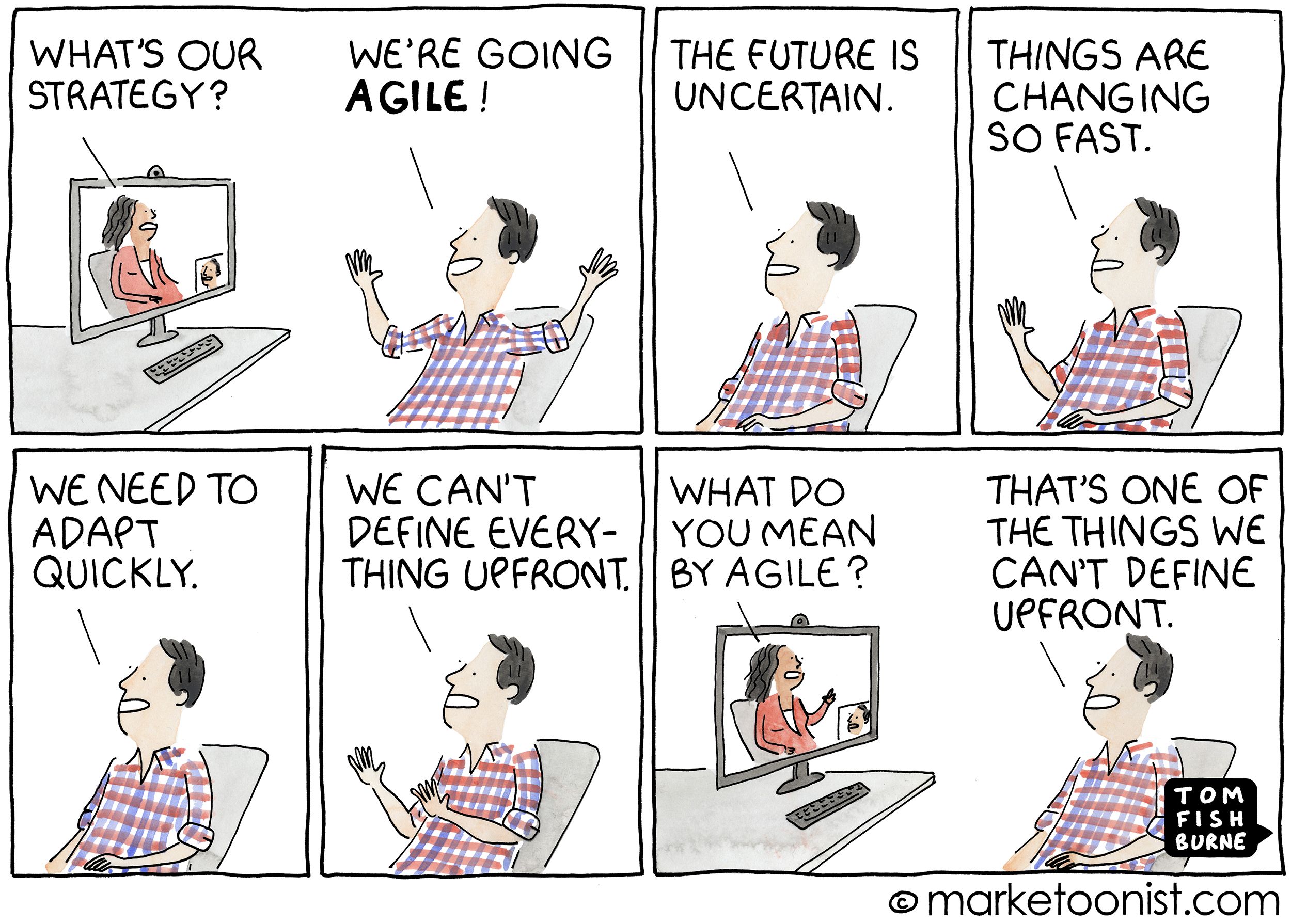How to become an Agile Organisation in 2021

Twenty years ago, 17 software engineers went on a skiing holiday. When they weren’t on the slopes, they shared their frustrations about the way software was being developed at the time. To address these, they came up with a Manifesto for Agile Software Development for faster delivery, greater responsiveness and to continually meet customer requirements. Agile Development is now in widespread use and the principles have been adopted to transform the wider organisation. Never have these principles been more relevant than now.
Unfortunately, over time the word Agile has been used as a buzzword and now many people hearing or using the word aren’t familiar with its true meaning in the context of organisational improvement. (Tom Fishburne, the Marketoonist illustrates this wonderfully in the cartoon above.)
The manifesto for Agile Software Development has the following 12 guiding principles which can be used by any organisation seeking to be Agile in order to adapt rapidly to change. The original texts are reproduced here, together with the context for applying them to the Agile Organisation.
- Customer satisfaction by early and continuous delivery of valuable software.
Meaning: instead of waiting for everything to be completed then rolling out one big improvement, seek to make many smaller improvements and make each one available as soon as they are completed so the benefits can be realised as early as possible. “Customers” can be internal as well as external.
- Welcome changing requirements, even in late development.
Meaning: don’t stick rigidly to the original plan if requirements or situations are changing around you. There’s no shame in changing a plan if it takes account of new requirements.
- Deliver working software frequently (weeks rather than months)
Meaning: Speed is everything. Although people may resist frequent changes, it is essential to keep pace with the rapidly changing business environment. Embrace an organisational culture of constant evolution.
- Close, daily cooperation between business people and developers
Meaning: Don’t make changes in isolation. Involve the people impacted by change both inside and outside the business: customers, suppliers, partners, sales, operations, support, logistics – they know what is needed, what will work and what might be challenging. Use them in the development process.
- Projects are built around motivated individuals, who should be trusted
Meaning: Assign responsibility and let the team get on with it – don’t be tempted to micro-manage. A trusted team will be faster, better and more effective.
- Face-to-face conversation is the best form of communication (co-location)
Meaning: OK, 20 years ago they didn’t have Zoom or Teams so this principle was intended to encourage personal interaction and conversations rather than emails and reports. Today video conferencing, collaboration software and Instant Messenger can help take the place of face to face interaction: establishing regular personal connections for faster, clearer, better communication.
- Working software is the primary measure of progress
Meaning: the most important measurement is of results, not the man-hours expended. In business terms, the essential measurement can be revenue, customer acquisition, speed of response, cost reduction or anything than makes a tangible difference to an organisation’s success.
- Sustainable development, able to maintain a constant pace
Meaning: bursts of development need to be underpinned by a sustainable discipline of reviewing, reflecting and adapting to changing circumstances. An all-hands burst of urgent activity may solve a problem in the short term but this cannot be reliably sustained. People, resources and processes must be aligned in a regular cadence to deliver consistently high performance. For example, a football team doesn’t simply show up for a match, there are regular activities and practice to build and maintain performance.
- Continuous attention to technical excellence and good design
Meaning: don’t abandon quality or best practice for short-term gain. Build in good quality and best practice for long-term sustainable improvement, even if it costs more and takes longer. It will be cheaper and better in the long term. A common example is training: in business operations, the cost of economising on training can be considerable.
- Simplicity—the art of maximizing the amount of work not done—is essential
Meaning: usually the simplest solutions are the ones that deliver results quickly and effectively. A more complex solution that takes twice as long to develop is unlikely to deliver twice the benefit – if anything, complex solutions often deliver less than simple solutions.
- Best architectures, requirements, and designs emerge from self-organizing teams
Meaning: another vote for setting team objectives and letting the team organise themselves in the best way to deliver it. This also means that a key element in the Agile Organisation is selecting and supporting the right team members so that they are empowered and can be trusted to deliver.
- Regularly, the team reflects on how to become more effective, and adjusts accordingly.
Meaning: Don’t plough on regardless,. Take time out to review and be bold in making necessary changes to improve effectiveness. A business cadence with time taken to reflect, review and adjust will be more than compensated for by time saved and improved outcomes further on.
You can see how these original 12 Principles were originally intended to change and improve the way software was developed. However these principles can just as easily be applied to any organisation committed to continuous evolution to ensure success. Consistently innovative companies such as Amazon, Apple, Samsung and Toyota* demonstrate that success comes to companies that can adapt rapidly – and this isn’t limited by size. Agile software development principles, reworded only slightly, can be the guiding principles for any Agile Organisation. Never has this been more important than it is now.
* The Most Innovative Companies 2020, BCG.COM
Neville Merritt and Olwyn Merritt
Pure Potential Development Limited
